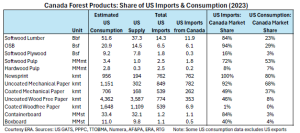
RUSS TAYLOR
As seen in Truck LoggerBC Spring 2025
BRITISH COLUMBIA – President Trump’s threatened use of tariffs on its key trading partners has started to turn much of the world upside down and what could happen is now being carefully analyzed by all countries.
On February 4, the US postponed its initially scheduled 25 per cent tariffs on Canadian and Mexican products until March 4, which were again postponed for another month. On February 19, addition-al tariffs on lumber, cars, and pharmaceuticals were set for all countries as of April 2.
On March 1, the White House issued two executive orders on lumber. The first order centres on the need to expand American timber production and the second directive looks to examine if imports of timber and lumber threaten national security.
As of March 14, Trump’s stream of ag-gressor tactics is undoing decades of mu-tual respect and trade between Canada and the US. Many analysts believe this damage with Canada will be difficult to repair and may never be repaired in whole—tariffs or no tariffs.
How can anyone operate a business with these on and off again arbitrary decisions? Investors, producers, customers and the public hate uncertainty, and the unexpected US tariff war has created this on a world scale.
President Trump does not believe that US needs Canadian lumber (or autos or energy and more). However, he is quite wrong, at least in the short-term, as Canada’s market share of US consumption is significant for the following major forest products: newsprint (80 per cent), uncoated mechanical paper (68 per cent), softwood pulp (53 per cent), coated mechanical paper (37 per cent), oriented strand board (29 per cent) and softwood lumber (23 per cent) (see table below).

Source: Spring 2025 TLA Magazine
Canadian softwood lumber exports to the US represent about 60 per cent of total Canadian production and 90 per cent of total export volumes. US import tariffs at 25 per cent could do serious short-term damage to the Canadian wood products industry, which is something Trump ap-pears to understand very well.
Of course, the US lumber market will see higher prices from a 25 per cent tariff on Canadian exports to the US given that Canadian lumber represents 23 per cent of US consumption, and these tariffs will be on top of the current 14.4 per cent anti-dumping (ADD) and counter-vailing duties (CVD) import duties (with the preliminary ADD increasing by 12.4 to 20.07 per cent about late August and the CVD increasing slightly in about early November under the sixth US Administrative Review.
The total ADD and CVD duties will be close to 30 per cent by November 2025. With added tariffs and current import penalties, the US end user and ultimately the consumer will be paying higher prices.
US lumber prices have been rising. In the month of February, green Douglas-fir 2×4 #2 & Better, free-on-board (FOB Portland) prices rose by 12.5 per cent and W-SPF 2×4 #2 & Better (FOB BC Mill) by 16.4 per cent. The Lumber Futures contract for March on the Chicago Mercantile Exchange was up 12 per cent from the end of January through to the end of February.
From March 1 to 14, lumber prices increased further, with W-SPF prices rising another 7 per cent and Lumber Futures up by 1 per cent. Add in a weakening Canadian dollar and the 25 per cent tariff on W-SPF 2×4 is essentially covered, at least as of mid-March.
Of course, no one knows what the master negotiator, President Donald Trump, has in mind. But many countries are scrambling to do what they can to avoid the threat of US tariffs. As a result, I expect volatile forest and wood product prices may persist into Q2 2025.
Russ Taylor, President of Russ Taylor Global


